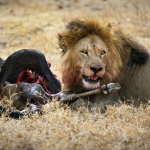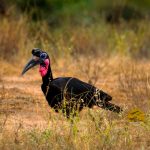Mongoose in Uganda: A Closer Look into the Fascinating Small Carnivores
Mongoose are some of the interesting families of carnivorous mammals that exist in different parts of the world, including Uganda. Specifically, common dwarf mongoose species Helogale parvula and banded mongoose Mungos mungo are found in Uganda. They thrive in Uganda’s varied habitats, from savannas to woodlands, playing a vital role in the ecosystem.
Physical Characteristics of Mongoose.
The dwarf mongooses are smaller, about 7 to 10 inches in length and weighing about 7 to 14 ounces. The banded mongooses are larger and may reach about 12 to 16 inches in length, weighing about 2 to 4 pounds. They both have smooth fur, pointed faces, and long tails which help them balance and with communication within their groups.
Habitat and Distribution in Uganda.
The range of the dwarf mongoose overlaps with that of the banded mongoose in savannas, grasslands, and woodlands; you will have the chance to see them in Murchison Falls National Park and Queen Elizabeth National Park. Both are small, social animals that like to live in groups or troops or packs.
Behavior and Social Structure.
Social mongooses are small, tight communities of high sociality and with complex social structures. Cooperative behaviors among the mongooses include grooming, foraging, or repelling perceived threats to their territories. The dynamics involve specialized roles among group members. For example, there are sentinels that keep watch for any danger while the others forage for food.
Dietary Habits of Mongoose.
They are omnivorous, feeding on insects, small reptiles, eggs, fruits, and seeds. Feeding habits help them reduce insect infestations that would otherwise be an ecological imbalance in their natural environment.
Reproduction of Mongoose.
Breeding in these groups is strictly controlled. Most often, it is a dominant breeding pair that monopolizes reproduction, assisted by other group members to raise the young. The gestation period varies but usually is about two months, after which females give birth to a litter of several pups.
Conservation Status in Uganda.
The common dwarf and banded mongooses occurring within Uganda are both, according to IUCN, species of least concern. Nevertheless, they are threatened by some habitat loss with human encroachment, often hunted for fur, or sometimes viewed as pests in places where agricultural activities are taking place.
Conservation Efforts in Uganda.
In Uganda, this involves habitat conservation and public awareness, as well as community-based conservation initiatives in terms of minimizing human-wildlife conflicts. Involving local communities in these conservation practices and land use would lessen the threats faced by these mongooses.
Comments on Mongoose in Uganda.
The species of mongooses found in Uganda are an addition to ecosystem processes and, in turn, play a crucial role in balancing their natural habitats. Because of their unique social behaviors, besides their ecological importance, they become even more intriguing subjects to study and conserve in the region.












